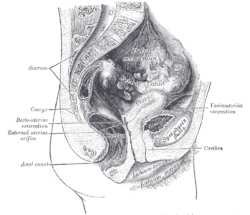Pouch of Douglas
| Recto-uterine pouch | |
|---|---|

Sagittal section of the lower part of a female trunk, right segment. (Excavatio recto-uterina labeled at bottom right.)
|
|

Median sagittal section of female pelvis. (Rectouterine excavation labeled at center left.)
|
|
| Details | |
| Identifiers | |
| Latin | excavatio rectouterina, cavum douglassi, fossa douglasi |
| MeSH | A01.047.025.600.225 |
| TA | A10.1.02.512 |
| FMA | 14728 |
|
Anatomical terminology
[]
|
|
The recto-uterine pouch, also known by various other names, is the extension of the peritoneal cavity between the rectum and the posterior wall of the uterus in the female human body.
In women it is the deepest point of the peritoneal cavity, posterior to (behind) the uterus and anterior to (in front of) the rectum. (The pouch on the other side of the uterus is the vesico-uterine pouch.) It is near the posterior fornix of the vagina.
It is normal to have approximately 1 to 3 ml (or mL) in the recto-uterine pouch throughout the menstrual cycle. After ovulation there is between 4 and 5 ml of fluid in the recto-uterine pouch.
In men, the region corresponding to the recto-uterine pouch is the recto-vesical pouch, which lies between the urinary bladder and rectum. (There is no equivalent to the vesico-uterine pouch).
The recto-uterine pouch, being the lowest part of the peritoneal cavity in a woman at supine position, is a common site for the spread of pathology such as ascites, tumour, endometriosis, pus, etc.
The recto-uterine (or rectouterine) pouch is also called the recto-uterine (or rectouterine) excavation, utero-rectal (or uterorectal) pouch, recto-vaginal (or rectovaginal) pouch, pouch of Douglas (after anatomist James Douglas, 1675–1742), Douglas pouch, Douglas cavity, Douglas space, Douglas cul-de-sac, Ehrhardt–Cole recess, Ehrhardt–Cole cul-de-sac, cavum Douglasi, or excavatio rectouterina. The combining forms reflect the rectum (, -rectal) and uterus (, -uterine).
In Obstetrics and Gynecology, it is most commonly referred to as the posterior cul-de-sac.
...
Wikipedia
